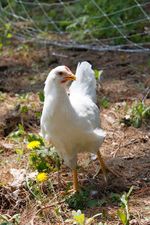Epistasis
Epistasis, a term that comes from Greek ἐπίστασις (epistasis) (ἐπί (epi) meaning upon, on, and στάσις (stasis), standing still, state), is a phenomenon that is the effect of a gene being dependent on the presence of one or more modifier genes (the gene pool). The term refers to a situation in which a double mutant shows the phenotype of one mutation but not the other[1]. In other words, epistasis occurs when two or more genes influence a trait, and one of them has a overriding effect on the phenotype[2]. This phenomenon is similar to dominance, the difference being that dominance implies masking genes in the same locus[3].
In epistasis, for double mutant alleles and genes with contrasting phenotypes, which may or may not be on the same chromosome, a gene is called epistatic if its mutant phenotype acts by inhibiting the mutant phenotype in another gene. The gene whose mutant phenotype suffers inhibition is termed hypostatic.[4]
Kinds of epistasis
Recessive epistasis
Recessive epistasis occurs when the epistatic allele is recessive. In other words, the recessive gene represses the action of the dominant gene. An example of recessive epistasis is what happens to the coat color of Labrador Retrievers. These dogs may have coats that are black, brown (or chocolate) or yellow (or gold). These colors are determined by the interactions between two genes at two loci. One locus determines the color type pigment produced by the skin cells. The dominant allele encodes the black pigment (in the table below: B) and the recessive, the brown pigment (in the table below: b). Alleles of the second locus affect the deposition of pigment in the hair shaft. The dominant allele allows the deposition (in the table below: E), while the recessive prevents the deposition (in the table below: e) [3]. The resulting genotypes and phenotypes are described in the table below:
| BE | Be | bE | be | |
|---|---|---|---|---|
| BE | BBEE(black) | BBEe(black) | BbEE(black) | BbEe(black) |
| Be | BBEe(black) | BBee(yellow) | BbEe(black) | Bbee(yellow) |
| bE | BbEE(black) | BbEe(black) | bbEE(brown) | bbEe(brown) |
| be | BbEe(black) | Bbee(yellow) | bbEe(brown) | bbee(yellow) |
Phenotypic ratio of F2 is 9: 3: 4.
Dominant epistasis
Dominant epistasis occurs when the dominant allele of a gene masks the expression of all other alleles of another gene. If an organism inherits one or two copies of the dominant allele, it will display the phenotypic trait.
The resulting genotypes and phenotypes of dominant epistasis in the case of the summer squash are described in the table below:
| WY | Wy | wY | wy | |
|---|---|---|---|---|
| WY | WWYY(white) | WWYy(white) | WwYY(white) | WwYy(white) |
| Wy | WWYy(white) | WWyy(yellow) | WwYy(white) | Wwyy(yellow) |
| wY | WwYY(white) | WwYy(white) | wwYY(white) | wwYy(white) |
| wy | WwYy(white) | Wwyy(yellow) | wwYy(white) | wwyy(green) |
Phenotypic ratio of F2 is 12: 3: 1
Duplicate recessive epistasis
Duplicate recessive epistasis is also known as having duplicate recessive genes. It occurs when the homozygous recessive alleles of both loci are epistatic with respect to the other allele's dominant locus. In this case, a distinct phenotype is produced in the presence of any homozygous recessive allele (aaB_; A_bb; aabb). The dominant alleles, when present together (A_B_), will produce another phenotype. One example is what occurs in the freshwater snail. The phenotypic ratio is illustrated in the table below:
| AB | Ab | aB | aa | |
|---|---|---|---|---|
| AB | AABB(pigmented) | AABb(pigmented) | AaBB(pigmented) | AaBb(pigmented) |
| Ab | AABb(pigmented) | AAbb(albino) | AaBb(pigmented) | Aabb(albino) |
| aB | AaBB(pigmented) | AaBb(pigmented) | aaBB(albino) | aaBb(albino) |
| aa | AaBb(pigmented) | Aabb(albino) | aaBb(albino) | aabb(albino) |
Phenotypic ratio of F2 is 9:7
Dominant and recessive epistasis
This kind of epistasis, also called dominant and recessive interaction, occurs when the dominant alleles of a locus (I) of the gene in both homozygous and heterozygous conditions (II, Ii) and homozygous recessive alleles (cc) of another gene locus (C) give rise to the same phenotype. An example occurs in chickens resulting from the crossing of the Leghorn and Plymouth Rock breeds. The Leghorn hens have white feathers due to the presence of the epistatic gene (I). On the other hand, Plymouth Rock chickens have white feathers because of the absence of a dominant gene (C). The table below shows the phenotypes of F2:
| CI | Ci | cI | ci | |
|---|---|---|---|---|
| CI | CCII(white) | CCIi(white) | CcII(white) | CcIi(white) |
| Ci | CCIi(white) | CCii(colored) | CcIi(white) | Ccii(colored) |
| cI | CcII(white) | CcIi(white) | ccII(white) | ccIi(white) |
| ci | CcIi(white) | Ccii(colored) | ccIi(white) | ccii(white) |
The phenotypic ratio of F2 is 13: 3.
Duplicate dominant genes
This type of epistasis occurs when a dominant allele of both gene loci produces the same phenotype without a cumulative effect, that is to say, independently. Example: Wheat kernel color. In this case, a functional enzyme A or B can produce a product from a common precursor giving color to the wheat seed. Therefore, only a dominant allele in any one of the two loci is required to generate the product. The table below shows the phenotypes and F2:
| AB | Ab | aB | aa | |
|---|---|---|---|---|
| AB | AABB(colored kernel) | AABb(colored kernel) | AaBB(colored kernel) | AaBb(colored kernel) |
| Ab | AABb(colored kernel) | AAbb(colored kernel) | AaBb(colored kernel) | Aabb(colored kernel) |
| aB | AaBB(colored kernel) | AaBb(colored kernel) | aaBB(colored kernel) | aaBb(colored kernel) |
| aa | AaBb(colored kernel) | Aabb(colored kernel) | aaBb(colored kernel) | aabb(uncolored kernel) |
The phenotypic ratio of F2 is 15: 1.
Duplicate genes with cumulative effect
This type of epistasis occurs when both non-allelic dominant alleles result in a new phenotype. When expressed independently, they result in separate phenotypic expression of their own. The table below shows the phenotypes and F2 in the case of the summer squash:
| WY | Wy | wY | wy | |
|---|---|---|---|---|
| WY | WWYY(disk-shaped) | WWYy(disk-shaped) | WwYY(disk-shaped) | WwYy(disk-shaped) |
| Wy | WWYy(disk-shaped) | WWyy(sphere-shaped) | WwYy(disk-shaped) | Wwyy(sphere-shaped) |
| wY | WwYY(disk-shaped) | WwYy(disk-shaped) | wwYY(sphere-shaped) | wwYy(sphere-shaped) |
| wy | WwYy(disk-shaped) | Wwyy(sphere-shaped) | wwYy(sphere-shaped) | wwyy(long shape) |
The phenotypic ratio of F2 is 9: 6: 1.
Epistasis and evolution
Walter ReMine points out that ordinary epistasis would normally increase the cost of substitution and therefore slow down evolution[5]. Haldane's Dilemma is a severe limit of the speed of evolution. Haldane’s model implicitly assumes no epistasis (or complex, favorable, interactions between the substituting mutations). The vast majority of biological traits (such as brains, hearts, blood clotting, vision, motility, hair, replication, metabolism, et cetera) are products of numerous genes, whose specific combination (not just any random combination of genes) is vastly more beneficial than any of the same genes taken alone or in smaller combinations. (The whole is greater than the sum of parts.) This type of epistasis (which is ordinarily what is meant by the term epistasis) occurs abundantly in nature – yet is usually de-emphasized or ignored in evolutionary genetics textbooks because it strongly aggravates evolutionary problems. [For example, sexual reproduction (when combined with this epistasis) is widely acknowledged to dramatically slow beneficial evolution because it breaks apart favorable combinations of genes each generation. This dramatic slowing of beneficial evolution magnifies the classic evolutionary problems with the origin and maintenance of sexual reproduction.] By assuming no such epistasis, Haldane’s model favors evolution and is consistent with most evolutionary discussions today.
References
- ↑ Griffiths, Anthony J. F.; Wessler, Susan R.; Lewontin, Richard C.; Carroll, Sean B (2008). Introduction to Genetic Analysis (9th ed.). New York: W. H. Freeman. p. 242-244. ISBN 978-0-7167-6887-6.
- ↑ Snustad, Peter; Simmons, Michael J (2010). Principles of Genetics (5th ed.). River Street, Hoboken, NJ: John Wiley & Sons. p. 76. ISBN 978-0-470-39842-5.
- ↑ 3.0 3.1 Pierce, Benjamin (2008). Genetics: A Conceptual Approach. New York: W. H. Freeman. p. 107-111. ISBN 978-0-7167-7928-5.
- ↑ Hartl, Daniel L.. Essential Genetics: A Genomics Perspective (5th ed.). Sudbury, Massachusetts: Jones and Bartlett Publishers. p. 372. ISBN 978-0-7637-7364-9.
- ↑ ReMine, Walter J (1993). The Biotic Message:Evolution Versus Message Theory. Saint Paul, Minnesota: St. Paul Science Publishers. p. 233. ISBN 0-9637999-0-8.





